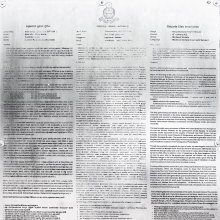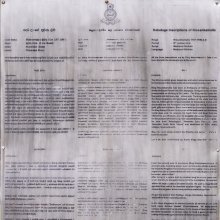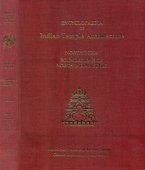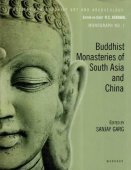Pandya, Pāṇḍya, Pamdya, Pandyan: 22 definitions
Introduction:
Pandya means something in Hinduism, Sanskrit, Jainism, Prakrit, the history of ancient India, Marathi. If you want to know the exact meaning, history, etymology or English translation of this term then check out the descriptions on this page. Add your comment or reference to a book if you want to contribute to this summary article.
Images (photo gallery)
In Hinduism
Purana and Itihasa (epic history)
Source: Google Books: Cultural History from the Vāyu PurānaPāṇḍya (पाण्ड्य) was one of the four sons of King Janāpīḍa. His janapada was the Pāṇḍyas.
Source: archive.org: Puranic Encyclopedia1) Pāṇḍya (पाण्ड्य).—A King of Vidarbha who was a great devotee of Śiva. One day while he was performing Śivapūjā at dusk he heard a loud noise outside the city and before completing the worship he went out and faced the enemies who were attempting to enter the city and killed its leader. He returned after the fight and without completing the worship took his meals. It was a sin to do so and the King was therefore born in his next birth as Satyaratha, a King, and was killed by his enemies. (Śatarudrasaṃhitā, Śiva Purāṇa). (See full article at Story of Pāṇḍya from the Puranic encyclopaedia by Vettam Mani)
2) Pāṇḍya (पाण्ड्य).—(A Tamilian dynasty of Kings.) A place of Purāṇic fame in Dakṣiṇa Bhārata. The three states Cera, Cola and Pāṇḍya were from early times renowned states of Dakṣiṇa Bhārata. Historically and Puraṇically Pāṇḍya was a state of eminence.
2) (A.) Historically. The Pāṇḍya dynasty of Kings is very ancient, The exact period of its beginning is still unknown. Megasthanes who lived in the fourth century B.C. has made mention of the Pāṇḍya dynasty in his diary. Julian, an emperor of Italy, who lived in 361 A.D. is stated to have received visitors from Pāṇḍyadeśa. The Pāṇḍya dynasty was revived and elevated under the leadership of Katuṅka in the 7th century A.D. From that time till the 16th century Madura was the capital of Pāṇḍyadeśa. The Uccāṅgī dynasty which was ruling the places to the south of Tuṅgabhadrā during the period from 9th century to 13th century A.D. is believed to be a part of the Pāṇḍyavaṃśa which had gone from Madura. A continuous history of the Pāṇḍya line of Kings is not available. Many Kings bear names like Jātavarmā or Māravarmā. The Pāṇḍya Kings were devotees of Śiva even from the period of the Jainas. At times they have ruled over the combined kingdoms of Cera and Cola. During the period from the 12th to the 14th century A.D. Pāṇḍya was ruled by five of the most valiant rulers and at that time the Pāṇḍyadeśa included all the places in south India up to Nellore. But the power of the Pāṇḍyas waned when the power of the Sultans who ruled Delhi spread to the south. After 1370 A.D only on rare occasions has the power of the Pāṇḍyas spread to the north of river Kāverī. In 1312 A.D. Kerala got herself free from the hold of the Tamilian Kings. (Pāṇḍyarājya).
Source: Cologne Digital Sanskrit Dictionaries: The Purana Index1a) Pāṇḍya (पाण्ड्य).—A son of Āndira and chief of the Pāṇḍyadeśa.*
- * Brahmāṇḍa-purāṇa III. 74. 6; Matsya-purāṇa 48. 5.
1b) One of the four sons of Janāpīḍa; his state, Pāṇḍyadeśa.*
- * Vāyu-purāṇa 99. 6.
1c) A southern tribe;1 Kingdom of.2
- 1) Brahmāṇḍa-purāṇa II. 16. 56. Matsya-purāṇa 114. 46; Vāyu-purāṇa 45. 124.
- 2) Matsya-purāṇa 163. 72.
Pāṇḍya (पाण्ड्य) is a name mentioned in the Mahābhārata (cf. II.13.20, II.28.48, III.86.10, VI.46.50) and represents one of the many proper names used for people and places. Note: The Mahābhārata (mentioning Pāṇḍya) is a Sanskrit epic poem consisting of 100,000 ślokas (metrical verses) and is over 2000 years old.

The Purana (पुराण, purāṇas) refers to Sanskrit literature preserving ancient India’s vast cultural history, including historical legends, religious ceremonies, various arts and sciences. The eighteen mahapuranas total over 400,000 shlokas (metrical couplets) and date to at least several centuries BCE.
Vaishnavism (Vaishava dharma)
Source: ISKCON Press: GlossaryPāṇḍya (पाण्ड्य).—The South Indian dynasty that ruled over Madurai and Rāmeśvaram in South India.

Vaishnava (वैष्णव, vaiṣṇava) or vaishnavism (vaiṣṇavism) represents a tradition of Hinduism worshipping Vishnu as the supreme Lord. Similar to the Shaktism and Shaivism traditions, Vaishnavism also developed as an individual movement, famous for its exposition of the dashavatara (‘ten avatars of Vishnu’).
Kavya (poetry)
Source: Shodhganga: The Kavyamimamsa of RajasekharaPāṇḍya (पाण्ड्य) is the name a locality mentioned in Rājaśekhara’s 10th-century Kāvyamīmāṃsā.—The district of Tinnevelley and Madura in modern Madras presidency. In the Raghuvaṃśa (VI. 59-60), Kālidāsa mentions Uragapura as the capital of the Pandya king.

Kavya (काव्य, kavya) refers to Sanskrit poetry, a popular ancient Indian tradition of literature. There have been many Sanskrit poets over the ages, hailing from ancient India and beyond. This topic includes mahakavya, or ‘epic poetry’ and natya, or ‘dramatic poetry’.
Jyotisha (astronomy and astrology)
Source: Wisdom Library: Brihat Samhita by VarahamihiraPāṇḍya (पाण्ड्य) refers to “Southern India”, according to the Bṛhatsaṃhitā (chapter 4), an encyclopedic Sanskrit work written by Varāhamihira mainly focusing on the science of ancient Indian astronomy astronomy (Jyotiṣa).—Accordingly, “If the two horns of the moon should appear but slightly raised and far from each other presenting the appearance of a boat, she brings trouble on the sailors but prosperity on mankind at large. If the northern horn of the moon should be higher [i.e., ardhonnata] than the other by one-half, the moon appearing like a plough, ploughmen will then suffer. They and their prince will be friendly and there will be prosperity in the land. If the southern horn should be higher than the other by one half, the appearance of the moon is also said to be plough like but of evil consequences. The ruler of Southern India will die [i.e., pāṇḍya-nareśvara-nidhanakṛt] and his army will engage in war”.

Jyotisha (ज्योतिष, jyotiṣa or jyotish) refers to ‘astronomy’ or “Vedic astrology” and represents the fifth of the six Vedangas (additional sciences to be studied along with the Vedas). Jyotisha concerns itself with the study and prediction of the movements of celestial bodies, in order to calculate the auspicious time for rituals and ceremonies.
In Jainism
General definition (in Jainism)
Source: archive.org: TrisastisalakapurusacaritraPāṇḍya (पाण्ड्य) is the name of an ancient kingdom, according to chapter 4.2 [vāsupūjya-caritra] of Hemacandra’s 11th century Triṣaṣṭiśalākāpuruṣacaritra: an ancient Sanskrit epic poem narrating the history and legends of sixty-three illustrious persons in Jainism.
Accordingly, as Vasupūjya and Jayā spoke to Vāsupūjya:—“All the existing kings, among men and the Vidyādharas, who are of good family, capable, heroic, wealthy, famous, possessing the fourfold army, known for guarding their subjects, free from blemish, faithful to engagements, always devoted to dharma, in Madhyadeśa, Vatsadeśa, [...] and other countries which are the ornaments of the eastern quarter; [... in the Pāṇḍyas, ...] these now, son, beg us constantly through messengers, who are sent bearing valuable gifts, to give their daughters to you. [...]”.

Jainism is an Indian religion of Dharma whose doctrine revolves around harmlessness (ahimsa) towards every living being. The two major branches (Digambara and Svetambara) of Jainism stimulate self-control (or, shramana, ‘self-reliance’) and spiritual development through a path of peace for the soul to progess to the ultimate goal.
India history and geography
Source: Wisdom Library: India HistoryPāṇḍya (पाण्ड्य) is the name of a country included within Dakṣiṇapatha which was situated to the south of the Vindhyas according to the Yādavaprakāśa. Dakṣiṇāpatha is a place-name ending is patha mentioned in the Gupta inscriptions. The Gupta empire (r. 3rd-century CE), founded by Śrī Gupta, covered much of ancient India and embraced the Dharmic religions such as Hinduism, Buddhism and Jainism.
Pāṇḍya as included within Dakṣiṇapatha is also mentioned by Rājaśekhara (fl. 10th century) in his Kāvyamīmāṃsā (chapter 17) who places Dakṣiṇapatha ahead of Māhiṣmatī.
Source: Ancient Buddhist Texts: Geography of Early BuddhismPāṇḍya (पाण्ड्य) (or Paṃḍiya) is the name of a locality situated in Dakkhiṇāpatha (Deccan) or “southern district” of ancient India, as recorded in the Pāli Buddhist texts (detailing the geography of ancient India as it was known in to Early Buddhism).—The Paṃḍiyas (Pāṇḍyas) are mentioned in the R.E. II and III of Asoka. Their country lay outside the southern frontiers of his vast kingdom. Asoka was in friendly terms with the Paṃḍiyas who had probably two kingdoms, one including Tinnevelly on the south and extending as far north as the high lands in the neighbourhood of the Coimbatore gap, the other including the Mysore State.
Source: Shodhganga: The significance of the mūla-beras (history)Pandya Dynasty (300 BCE–1650 CE):—The high period of the late Dravidian style of the Pandyas can be placed during 1100-1350 AD. The Pandyas followed the Cholas. Magnificent temples erected by the late Pandyas equal the late Chola gopuras at Chidambaram. The eastern gopuram at Chidambaram erected by Sundara Pandya (AD 125I-1268), and the ones at Jambukesvaram and Srirangam are magnificent structures closely resembling the Chola gopuras.

The history of India traces the identification of countries, villages, towns and other regions of India, as well as mythology, zoology, royal dynasties, rulers, tribes, local festivities and traditions and regional languages. Ancient India enjoyed religious freedom and encourages the path of Dharma, a concept common to Buddhism, Hinduism, and Jainism.
Languages of India and abroad
Marathi-English dictionary
Source: DDSA: The Molesworth Marathi and English Dictionarypaṇḍyā (पंड्या).—m ( H) A tribe of Hindustani Brahmans or an individual of it.
--- OR ---
paṇḍyā (पंड्या) [or पंड्याऊस, paṇḍyāūsa].—m (See puṇḍyāūsa) A variety of sugarcane.
--- OR ---
pāṇḍyā (पांड्या).—m A half-grown tiger. 2 A village-officer. He is employed in the customs &c. The term is understood by Shudras of the kuḷakaraṇī. 3 ( H) A title of Brahmans of the pañcagauḍa division (Hindustani Brahmans); the bhaṭa or family or personal priest amongst the bhayyā or para- dēśī people.
Source: DDSA: The Aryabhusan school dictionary, Marathi-Englishpaṇḍyā (पंड्या).—m A tribe of Hindusta'ni' Bra'h- mans or an individual of it.
--- OR ---
paṇḍyā (पंड्या) [or paṇḍyāūsa, or पंड्याऊस].—m A variety of sugar- cane.
--- OR ---
pāṇḍyā (पांड्या).—m A half-grown tiger. A village officer. A title of Brahmans of the pañcagauḍa division (Hindustani Brah mans).
Marathi is an Indo-European language having over 70 million native speakers people in (predominantly) Maharashtra India. Marathi, like many other Indo-Aryan languages, evolved from early forms of Prakrit, which itself is a subset of Sanskrit, one of the most ancient languages of the world.
Sanskrit dictionary
Source: DDSA: The practical Sanskrit-English dictionaryPāṇḍyā (पाण्ड्या).—m. (pl.) Name of a country and its inhabitants; तस्यामेव रघोः पाण्ड्याः प्रतापं न विषेहिरे (tasyāmeva raghoḥ pāṇḍyāḥ pratāpaṃ na viṣehire) R.4.49.
-ṇḍyaḥ A king of that country; पाण्ड्योऽयमंसार्पितलम्बहारः (pāṇḍyo'yamaṃsārpitalambahāraḥ) R.6.6.
Derivable forms: pāṇḍyāḥ (पाण्ड्याः).
Source: Cologne Digital Sanskrit Dictionaries: Shabda-Sagara Sanskrit-English DictionaryPāṇḍya (पाण्ड्य).—m. (-ṇḍya) plu. 1. Name of a country and its inhabitants. 2. Sing. A king of that country.
Source: Cologne Digital Sanskrit Dictionaries: Benfey Sanskrit-English DictionaryPāṇḍya (पाण्ड्य).—m. 1. pl. The name of a people and its country. 2. A prince of the Pāṇḍyas. 3. The name of a mountain.
Source: Cologne Digital Sanskrit Dictionaries: Cappeller Sanskrit-English DictionaryPāṇḍya (पाण्ड्य).—[masculine] [plural] [Name] of a people.
Source: Cologne Digital Sanskrit Dictionaries: Monier-Williams Sanskrit-English Dictionary1) Pāṇḍya (पाण्ड्य):—[from pāṇḍu] m. [plural] Name of a people and country in the Dekhan (also [varia lectio] for pāṇḍu, m. [plural] a people in Madhya-deśa), [Mahābhārata; Kāvya literature] etc.
2) [v.s. ...] (sg.) a prince of the Pāṇḍyas, [ib.] (cf. [Pāṇini 4-1, 168], [vArttika] 3, [Patañjali])
3) [v.s. ...] Name of a son of Ākrīḍa, [Harivaṃśa]
4) [v.s. ...] of the mountain range in the country of the P°s [Mahābhārata; Rāmāyaṇa]
Source: DDSA: Paia-sadda-mahannavo; a comprehensive Prakrit Hindi dictionary (S)Pāṇḍya (पाण्ड्य) in the Sanskrit language is related to the Prakrit word: Paṃḍa.
[Sanskrit to German]
Sanskrit, also spelled संस्कृतम् (saṃskṛtam), is an ancient language of India commonly seen as the grandmother of the Indo-European language family (even English!). Closely allied with Prakrit and Pali, Sanskrit is more exhaustive in both grammar and terms and has the most extensive collection of literature in the world, greatly surpassing its sister-languages Greek and Latin.
Kannada-English dictionary
Source: Alar: Kannada-English corpusPaṃdya (ಪಂದ್ಯ):—
1) [noun] a solemn promise or pledge dedicating oneself to an act, service or way of life; a vow; a pledge.
2) [noun] utterly unyielding and quarrelsome in attitude; adamancy.
3) [noun] a striving in competition or rivalry with another; a vying.
4) [noun] any game of uncertainty played with a wager.
5) [noun] (in gen.) any game played by two teams to establish supremacy of one over the other.
6) [noun] a pledge of a forfeit risked on some uncertain outcome; wager; a bet.
7) [noun] haughtiness; insolence; disdain; arrogance.
8) [noun] an announcement, declaration or narration made in an open or ostentatious way.
--- OR ---
Pāṃḍya (ಪಾಂಡ್ಯ):—
1) [noun] an erstwhile country in southern India, having Madhurai as its capital and was known for its political power and culture.
2) [noun] any of the kings who ruled this country.
Kannada is a Dravidian language (as opposed to the Indo-European language family) mainly spoken in the southwestern region of India.
See also (Relevant definitions)
Starts with: Pamdyakattu, Pamdyata, Pandyadesha, Pandyaja, Pandyakavataka, Pandyamathura, Pandyanareshvara, Pandyanatha, Pandyaraja, Pandyarashtradhipa, Pandyausa, Pandyavata, Pandyavataka.
Ends with: Antahspandya, Deshapandya, Ghalapandya, Ghatapandya, Kudurepamdya, Kunapandya, Rajasimhapandya, Saradeshapandya, Spandya, Sundaravirapandya, Uttarapandya, Varapandya, Virapandya.
Full-text (+235): Panda, Malayadhvaja, Pandyadesha, Minakshi, Valuti, Pamdyata, Pandyavataka, M'pandya, Minavat, Minatchi, Kanninatu, Pandyaraja, Ghalapandya, Sundarapandyadeva, Namabhidhana, Pandyanareshvara, Pandyanatha, Pandyarashtradhipa, Pandyavata, Arjunapura.
Relevant text
Search found 68 books and stories containing Pandya, Pāṇḍya, Pamdya, Pandyan, Pāṇḍyā, Paṇḍyā, Paṃdya, Pāṃḍya; (plurals include: Pandyas, Pāṇḍyas, Pamdyas, Pandyans, Pāṇḍyās, Paṇḍyās, Paṃdyas, Pāṃḍyas). You can also click to the full overview containing English textual excerpts. Below are direct links for the most relevant articles:
Diaspora of Bhuta (Daiva) worshipping cult—India and Indonesia (by Shilpa V. Sonawane)
Part 1.5 - Pandyan Dance < [Chapter 4 - Inter-Disciplinary Analysis]
Part 1.4 - Tamil King who will Register the Vietnam King Sri Maran < [Chapter 4 - Inter-Disciplinary Analysis]
Part 1.6 - Bhutala Pandya Aliyasantana < [Chapter 4 - Inter-Disciplinary Analysis]
Later Chola Temples (by S. R. Balasubrahmanyam)
Chapter XV - Rajendra III (A.D. 1246 to 1279/80)
Temples in Ponnamaravati < [Chapter VIII - Temples of Rajaraja II’s Time]
The history of Andhra country (1000 AD - 1500 AD) (by Yashoda Devi)
Part 36 - Viragandagopala (A.D. 1292-1302) < [Chapter XX - The Telugu Cholas (Chodas)]
Part 19 - Viragandagopala (A.D. 1243-1253) < [Chapter XII - The Pallavas]
Part 35 - Rajagandagopala alias Ranganatha (A D. 1299-1325) < [Chapter XX - The Telugu Cholas (Chodas)]
Early Chola Temples (by S. R. Balasubrahmanyam)
Temples in Kodumbalur < [Chapter IV - Temples of Sundara Chola’s Time]
Introduction < [Chapter III - Sundara Chola alias Parantaka II Madurantaka]
Introduction < [Chapter I - Parantaka I (Madirai-Konda Parakesari)]
Sanskrit sources of Kerala history (by Suma Parappattoli)
2. Kerala in the Puranas < [Chapter 6 - Miscellaneous Sanskrit works bearing on Kerala history]
The Cidambaram inscription of Jatavarman Sundara Pandya < [Chapter 1 - Historical details from Sanskrit Inscriptions]
4. Pradyumnabhyudaya by Ravivarma Kulasekhara < [Chapter 5 - Sanskrit Dramas and Campus bearing on Kerala History]
Puranic encyclopaedia (by Vettam Mani)
Related products



